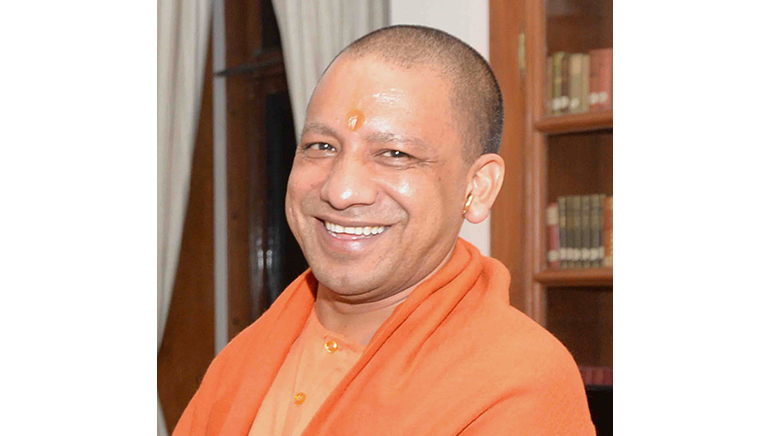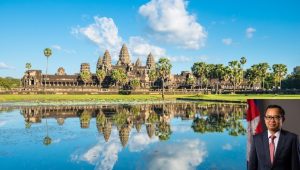Turning Uttar Pradesh into Uttam Pradesh
Starting his political career by becoming the youngest Member of Parliament from Gorakhpur to be elected to the 12th Lok Sabha at the age of 26, Shri Yogi Adityanath has been consistently ranked as one of the most popular Chief Ministers in India. Dedicated to the selfless service of the nation, he has been leaving no stone unturned in turning the wheels of progress and prosperity in Uttar Pradesh with his unswerving dedication and relentless persistence
STRIKING FAST-PACED DEVELOPMENT
Q. Sir, we, at AsiaOne, appreciate the fact that under your able leadership, the Uttar Pradesh government has achieved a drastic improvement in law and order, investments, and infrastructure development in the state over the last four years. Your efforts to promote spiritual tourism with focus on Ayodhya, Prayagraj, Mathura and Varanasi are appreciable so are the various upcoming infrastructure projects such as 354-km Bundelkhand-Purvanchal Expressway project and 1050-km Ganga Expressway from Meerut to Prayagraj – the largest expressway in India. We also appreciate your goal of making Uttar Pradesh a $1 Trillion Economy.’ Please throw light on some of the other sectors on your government plans to focus with the agenda of making Uttar Pradesh as ‘Uttam Pradesh.’ In fact, it is a matter of great pride that Hon’ble Prime Minister Shri Narendra Modi ji lauded you and your government for the pace of the development despite the COVID-19 pandemic.
A. You have aptly mentioned about our government’s effort in transforming the law and order situation, tourism and industrial sector of the state. In the coming 5 years we will have completed the construction of the Noida International Greenfield Airport and half the work on Ganga Expressway. We have further boosted the health infrastructure and education infrastructure in the state.
ALIGNING STATE GOALS WITH NATIONAL GOALS
Q. Sir, what are your views on Hon’ble PM Modi ji’s call for ‘vocal for local’ and ‘Aatma Nirbhar Bharat’? How is your government planning to further this agenda?
A. “One District One Product (ODOP)” launched in 2018 is the flagship programme of Government of Uttar Pradesh (GoUP). The objective of the programme is to preserve, develop and promote local arts, crafts and traditional skill of communities spread across each district of Uttar Pradesh. For example, the artisans’ of the old wood carving industry of Saharanpur needed training. Now under the ODOP initiative, we are providing training facilities to them. This will not only improve the products, but will also improve efficacy. Additionally, the programme aims to add to the income and local employment and is in line with Hon’ble PM’s clarion call of ‘Vocal for Local’ and ‘Atmanirbhar Bharat’.
Loans to the tune of Rs 10,390 crore to 3,54,825 MSME units and tool kits to 5,000 artisans under ODOP were given during a special online loan mela organized by the government. 3,24,911 new MSME units have been given loans of Rs 9,074 crore under various central and state government schemes like PM Rozgar Srijan Yojana, CM Yuva, Swarozgar Yojana, ODOP, Mudra Yojana and Atma Nirbhar Bharat. Under Atma Nirbhar Bharat, 29,914 existing units were given Rs 1,316 crore in loans.
BOOSTING EMPLOYMENT
Q. Sir, owing to your dedicated efforts, Uttar Pradesh has emerged as the biggest contributor to employment generation in the country. The state has ensured employment to more than 57 lakh unskilled workers who are now engaged in various projects under MGNREGS – contributing 18 per cent of the total employment in the country under the scheme. In fact you are a role model for the youth of the nation who identify with you and look up to you for inspiration. What’s your message to them?
A. My message to the youth is to keep working hard, take pride in being from Uttar Pradesh and become brand ambassadors of the state. I would further like to encourage them to not just be a job seeker but also be a job generator i.e. learn about entrepreneurship.
The Uttar Pradesh Government is focused on generating employment and achieving its goal of reaching $1 trillion economy. Our special campaign “Mission Rojgar” aims at providing jobs to 50 lakh youth by March 2021 and so far has employed 21,75,443 youth in the state. In the past 4 years, more than 4 lakh youths have been given employment within the government. Uttar Pradesh has been ranked first in the country for generating 10 crore man days under the Garib Kalyan Rojgar Abhiyaan to support migrant labourers who came back to the state during the pandemic.
The Uttar Pradesh government did not only manage the return of about 40 lakh migrants from all over the country but also took up the onerous task of providing them employment. In a first, the state government did skill mapping of about 36 lakh migrant labourers/workers to enable them get job as per their skill set. 4 lakh youths have already got government jobs and about 15 crore youths got self-employment by way of various schemes of the Centre and the State.
Uttar Pradesh has also found place among top five states of the country for providing employment under the Micro, Small and Medium Enterprises (MSMEs) during Corona pandemic. In a recent report of Reserve Bank of India (RBI), Uttar Pradesh has secured a place ahead of Karnataka, Rajasthan, Delhi, Haryana and Telangana in the list of top 10 states.
The state government also signed MoUs with various industries for creation of 11 Lakh jobs within a year. While FICCI and IIA will account for three lakh jobs each, realtors’ body NARDCO and the Laghu Udyog Bharti have agreed to provide jobs to 2.5 each to migrant labourers.
PROMOTING TOURISM
Q. Your government has been promoting tourism with the tagline of “UP nahi dekha, toh India nahi dekha” (If you have not seen UP, then you have not seen India too). Please elaborate.
A. Uttar Pradesh has a myriad of tourism attractions spread across wildlife & nature, historical monuments, heritage & culture, vibrant cities, cuisine, art & craft, music & dance, adventure, spirituality and religion. Such diversity spread across all districts of Uttar Pradesh makes for an unforgettable tourism experience. And therefore, the tagline because Uttar Pradesh is a must visit place. Uttar Pradesh emerged as the top destination for attracting the highest number of domestic tourists in 2019. The Indian Tourism Statistics (ITS), 2020 announced that as many as 53.6 crore domestic tourists visited Uttar Pradesh in 2019 which was much higher as compared to 2018.
With the objective of improving the basic tourism infrastructure across all our destinations (popular and new), development projects to the tune of INR 630.45 Crore are being implemented under the ‘Swadesh Darshan & PRASAD Scheme’. In addition, infrastructure development projects of INR 857.20 Crore are also being implemented from the state government funding.
The projects sanctioned under the Swadesh Darshan Scheme includes the:
- Development of Sravasti, Kapilvastu and Kushinagar under the Buddhist Circuit;
- Development of Kalinjar Fort (Banda), Maghar Dham & Chauri Chaura under the Heritage Circuit;
- Development of Ayodhya, Chitrakoot & Shringverpur under the Ramayana Circuit;
- Development of Gorakhpur, Devipatan, Dumariyagunj, Banda & other tourist sites across the state under the Spiritual Circuit. Mathura and Varanasi are also being developed under the PRASAD Scheme, along with new ‘River Cruise’ project at Varanasi.
Major works include development of tourist facilitation centre, façade lighting of monuments, signage, landscaping, drinking water kiosks, solar lighting and toilets. In addition to the above, Uttar Pradesh Tourism Policy was launched in February 2018, to attract private investments and develop tourism infrastructure.
Till now, the state has received multiple project proposals for new hotels, resorts, convention centres, wellness centres, adventure tourism projects and other facilities with investment intent of approximately INR 18,753 Crore. Tourism destinations have been categorized across 12 tourism circuits like Ramayana, Braj, Buddhist, Wildlife & Eco Tourism, Bundelkhand, Mahabharata, Shakti Peeth, Aadhyatmik, Sufi, Jain, Craft and Swatantrata Sangram.
244 tourism investment proposals have been received in these tourism circuits, which will assist in the overall tourism infrastructure development of the region. One of the major fiscal benefit offered under the tourism policy is the ‘Capital Investment Subsidy’ in the range of 1020% of the eligible capital investment, which encourages the private entities to establish new tourism units. Furthermore, the state government is planning to develop camping infrastructure and adventure activities at various eco-tourism sites. As part of public & private sector collaboration to train local young community, over 200 young people in Ayodhya were trained by sector specialists, under the ‘Ayodhya Guide training Program’.
DEVELOPMENT OF FILMCITY & JEWAR INTERNATIONAL AIRPORT
Q. Your Government has recently announced a film city of over 1,000-acre plot located just about 6 km from the proposed Jewar International Airport. The latter will be the first net-zero emissions airport in its class, setting a new standard for sustainable aviation. Please throw light on the vision behind these initiatives.
A. Uttar Pradesh has played a pivotal role in the rise of Indian cinema. The idea behind the Film City in Noida is to develop the state as an important centre for the production of films and promote our tourist destinations. We already provide huge subsidies to film makers and lately, UP have been buzzing with film shooting activities in the past few years. The Uttar Pradesh government last year cleared subsidy worth over INR112.4 million for 16 Hindi and six Bhojpuri films.
The Noida International Greenfield Airport will become a global brand and the pride of India and will cater to 12 million passengers. The site clearance for the airport has already been done. Over the past three years, various clearances, including security, environment, bidder, etc followed and international organisation Zurich Airport International AG will be developing the airport.
Architecture firms Nordic Office of Architecture, Grimshaw, Haptic and consultants STUP will design a carbonneutral terminal. A goal of carbon net-zero and a LEED Gold standard certification has been set for the airport terminal, which will have the capacity to serve 30 million passengers per year. Carbon net-zero, also known as carbon-neutral design, is a term for buildings that seek to remove as much carbon dioxide from the atmosphere as they put in.
MISSION SHAKTI INITIATIVE FOR THE SAFETY, DIGNITY & EMPOWERMENT OF WOMEN
Q. Please throw light on the Mission Shakti initiative launched by your government for boosting gender equality in the state.
A. Mission Shakti is working aggressively for empowerment of women. Notable steps have been taken for success of the Mission Shakti campaign that aims at ensuring women security, self-reliance and dignity in Uttar Pradesh. Distribution of dry ration among women is being done by Bal Vikas Evam Pushtahaar Vibhag and Food and Civil Supplies at the anaganwadi centres in the state. And to raise awareness about several welfare programmes of the government and also about the helpline numbers such as 1090, 1076, 1098, 108, 102, 112 and others. The SHGs also used rangolis as a means to spread the message about women empowerment and helpline numbers among the villagers.
Efforts are also being made to help the most underprivileged women of the groups through the welfare schemes of the government so that they are able to support their families. The police officers make it a point to interact with the women to inform them about their rights. Under the welfare schemes, the women are told in detail about the Kanya Sumangala Yojana, Ujjawala Yojana, Ayushman Bharat, how to open bank accounts, Pradhanmantri Jeevan Jyoti Yojana, and Pradhanmantri Suraksha Beema Yojana.
The Mahila Shakti Kendra team of Rupapur, Pratapgarh reached out to women and girls to spread the message of women empowerment under the Mission Shakti campaign. The WCD department has sensitised more than 5 crore citizens of the state about issues women face. Platforms like Shakti Samvad and Haq Ki Baat are being used to redress the grievances of both rural and urban women. To acknowledge the contribution of women and girls in different fields, events such as Nayika Mega Event, Gender Champion are being held on regular basis. The government has helped 27.95 lakh women through the Nirashrit Mahila Pension scheme while 5.80 lakh girls have received the benefits of Kanya Sumangala Yojana. As many as 51,25,579 girls have got the direct benefit of ‘Beti Bachao, Beti Padhao’ scheme. Through the Rani Lakshmi Bai Mahila Evam Samman Kosh Yojana, 4,937 victims of violence have been supported.
The Uttar Pradesh Prohibition Of Unlawful Conversion Of Religion Ordinance 2020 was passed as well. The ordinance was passed as in recent times a lot of cases were being registered where the women complainants complained about how they were being forced to change their religion and on refusing to convert, were being harassed. We realised that this situation had to be dealt with in order to protect the interest of women/ minors and ensure safety and justice to them by giving them the right to complaint against any deceit and harassment. It is a duly constituted law and law per se isn’t discriminatory. The law isn’t a means to stop any inter-faith marriages from happening but rather to protect the marriages whereby the woman has been duped/lied by the man into an inter-faith marriage.
The law aims to prohibit unlawful conversion from one religion to another by misinterpretation, force, undue influence, coercion, allurement or by any fraudulent means or by marriage. The law aims to make inter-faith marriages null and void if, upon investigation, they have been found to involve forced conversion or harassment. The law also looks to impose a jail term of between two and seven years where forced conversion involves minors or women belonging to a Scheduled Caste or Scheduled Tribe.
SAFEGUARDING THE INTEREST OF FARMERS
Q. Please shed light on some of the initiatives related to welfare and the growth of the agriculture sector in Uttar Pradesh. Please state some of the measures undertaken by your government for the welfare of farmers during the lockdown and the various schemes launched for the prosperity of farmers.
A. Farmers are the backbone of the Uttar Pradesh economy and their welfare and the growth of agriculture sector has been the state government’s top priority since 2017. Prior to 2017, farmers in Uttar Pradesh faced innumerable challenges and were distressed as government procurement was low and realisation of MSP was low and therefore, the income was meagre.
The new government in 2017 under the leadership of Yogi Adityanath realised the distress which farmers were facing and immediately waived off farmers’ loans worth INR 36,000 crore that benefited more than 56 lakh farmers and chartered a holistic strategy which established longterm goals and guided the intervention which included providing new technology and other complementary farming assets. Yogi Adityanath’s deft knowledge of farming methods (at Gorakhnath math he was responsible for ‘farm to shop’ sale of the produce) has proved as an asset.
The agriculture budget of the state registered a record hike from INR 4,096 crore in 2017-18 to INR 10,378 crore in 2018-19 and settled at INR 6,231crore in 2019-20 afterwards.
About 58 percent of the population is dependent on the agriculture sector but agriculture and the allied sector contribute only 26 percent to the state’s gross domestic product (GDP). On the basis of the data, the focus of Chief Minister Yogi Adityanath was to increase agricultural production in the state and to give the farmers a fair price for their crops via farmer-friendly policies. In order to empower farmers economically, the underlying causes were addressed by the government.
Uttar Pradesh remains the top state when it comes to sugarcane production. Over 47 lakh sugarcane farmers in Uttar Pradesh have been paid overdue payments of the last government of more than INR 1,15, 000 crore between 2017-2020. This cane price payment is much more than the cane price payment of INR 95,215 crore paid during the five year tenure of the previous government from 2012-2017. The previous government sold 21 sugar mills at throw away prices in Purvanchal wherein the current government has opened sugar mills in Gorakhpur and Basti which were closed in 1999 and can now process four times more sugarcane. The government currently operates 119 sugar mills in total.
Previously, water wouldn’t reach till the canal tail end and farmers were forced to draw water from tube wells. The state’s irrigation department ensured that the water reached till canal tail end to help farmers. The irrigation projects which were stalled for past 10-15 years were restarted and completed. Water has reached every farm under the Prime Minister Agriculture Irrigation scheme.
Also, the government decided to empower farmers by ensuring power in the villages for 18-20 hours. Furthermore, PM Gram Sadak Yojana has completed several phases and most of the villages have been connected via this scheme which has eased the commuting of the farmers. Recently, Chief Minister Yogi Adityanath also inaugurated various projects under Pradhan Mantri Gram Sadak Yojana.
TECHNOLOGY UPTURN
The state already has four agricultural universities. Recently, a central agricultural university was inaugurated by Prime Minister Narendra Modi Ji in Jhansi. Presently, 89 Krishi Vigyan Kendras are working in Uttar Pradesh with a resolve to double the income of farmers with the help of new concepts and technologies. The previous government had refused to take these 20 Krishi Kendras from the center.
More farmers have been provided ‘Kisan Credit Card’. In 2016-17, 100.42 lakh farmers had KCC but as of October 30 this year, 161.08 lakh farmers have the KCC.
A centre of the International Rice Research Centre, Philippines, has been opened in Varanasi and efforts are also being made to open a centre of International Potato Research Centre. In the last three years, about INR 300 crore has been given to Krishi Vigyan Kendras and other agricultural institutions.
Weather-based crop insurance for protection of crops is being provided at a mere 5 percent premium and mandi fee has been reduced from 2 percent to 1 percent. At least 50 percent grant is also being provided on construction of poly houses.
In addition, 80 percent subsidy is being provided on agricultural equipment like sprinklers under the `Per Drop More Crop’ scheme. Such equipment saves water and also increases the production of crops.
With the aim to promote horticulture, vegetable and fruit farming in the Purvanchal region as it is very effective in doubling the income of farmers of this region, the government has given vegetable seeds free of cost to over 20 lakh farmers.
The horticulture sector has immense potential in Purvanchal. In this region, while cereals are ready in six months, vegetables take 2-3 months to reap. Farmers are being made aware of such technology so that they can earn maximum income from horticulture.
Boosting Farm Exports
The UP Export Policy 2020-25 has been approved by the state cabinet which aims at doubling the income of farmers and increasing exports from the agricultural sector.
Chandauli, known as the rice bowl of the Purvanchal, is now exporting black rice to countries, including Australia and New Zealand. Two mango packaging houses have been constructed in Amroha and Varanasi at a cost of INR 9.90 crore each. During the coronavirus times, about 2,000 quintal mangoes have been exported from this region.
Eastern Uttar Pradesh is one of the potential areas for export of fresh fruits and vegetables, such as green chillies, okra, bitter guard, green peas, brinjal and mango and guava etc. and they have been exported to countries like Dubai and Europe.
Under ‘One District One Product’ initiative of the government 45 districts have been identified. Agricultural products will be selected on the basis of agro-climatic zone, product quality, taste, aroma, nutritional and medicinal properties, and export potential. Farmers of the respective districts have been recommended about growing specific crops.
Products like ‘Kalanamak rice’ of Siddharthanagar, banana fibre of Kushinagar, banana of Kaushambi, jaggery of Ayodhya, aamla of Pratapgarh, pulses of Balrampur and Gonda, desi ghee of Auraiya, handicraft made of wheat stalk in Bahraich, wooden toys of Chitrakoot, wooden artifacts of Saharanpur, Basti, Bijnor, Rae Bareli etc. are included in the ODOP scheme.
The government is working to ensure global branding of Kala Namak variety of rice on the lines of Basmati rice. A project for promoting Kala Namak rice had been prepared in association with the International Rice Research Institute at Varanasi, Indian Agriculture Research Institute and Acharya Narendra Dev Agriculture University of Ayodhya.
Attracting Industries
UP is the largest potato producing state in the country. Potatoes are sown in an area of 6.1 lakh hectares in the state. Last year, UP produced 147.77 lakh tonnes of potatoes till November 2020 and farmers received a good price of potatoes. It is predicted that this time the state will set a new record in potato cultivation.
It has been estimated that at least 26.50 to 27.50 tonnes per hectare of potatoes have been cultivated. The figure is expected to reach 30 tonnes per hectare next year.
Till a few years ago, potato farmers did not get fair prices for potatoes, but now potato farming in UP started to be a profitable deal for the farmers as the quality of the yield has improved. Not only here, multinational Food and Beverages company ‘PepsiCo’ is also going to set up a new (greenfield) potato chips production unit in the state with an investment of INR 814 crore.
The unit will be set up on about 35 acres of land provided by the State Industrial Development Authority (UPSIDA) in Kosi-Mathura. Starting in 2021, over 1000 people will get direct and indirect employment from this chips factory. This is the first time that a greenfield project is being set up by PepsiCo itself in Uttar Pradesh and by the time production starts from this factory, Uttar Pradesh will also become the first state in the country in terms of potato production.
During the COVID19 lockdown when globally farmers suffered, farmers produce procurement was carried out directly from their homes by the government and it was made sure that shop selling seeds and other farming items remained open. As the Rabi crop in UP got ready for harvesting amid the lockdown, the state government set up 6,000 procurement centres to help farmers sell their produce and these centres functioned successfully adhering to all precautions. These centres procured 36 lakh metric tonnes of wheat.
Even during the corona pandemic, when all the industries were facing closure, the sugar mills of the state continued crushing operations. It was the commitment of government for safeguarding the interest of farmers, that the supply of their sugarcane remains uninterrupted during the lockdown period. Though the sugar sale remained negligible during the lockdown, but in spite of that, cane price payment of Rs 5,953 crore was made to farmers in that period.
Farmer-friendly Initiatives
Soil health cards were provided to millions of farmers by the state government. Thousands of farmers have been provided 40 to 90 per cent subsidy through a custom hiring centre for purchasing agricultural machinery — this amount has been transferred directly to the farmers’ bank accounts. The government has already announced a policy for FPOs (farmers producers organisation) and the process of constituting the FPOs at block level was underway.
Farmers also needed assistance to develop the capacity necessary in order to increase their incomes. For this, a vital first step is to provide them with training as well as agricultural inputs and credit so that they can produce more, aggregate their crops, and market them collectively. It is noteworthy that through “The Millions Farmers’ initiative farmers have been given training in improved farming at the Nyaya Panchayat level. MFS, also popularly known as Kisan Pathshala, is an extension program that the government of UP initiated in 2017 with a view to encourage the use of modern farming techniques, to make farming more profitable, sustainable, and resilient.
Unlike traditional extension services, MFS integrates various facets of agricultural knowledge into a packaged format, and delivers it through village-level trainings across all districts in the state. Printed materials—booklets, pamphlets— with such information are also distributed among participants.
The key objective of the MFS is to impart agricultural knowledge and techniques to farmers, which in turn can enhance agricultural production, improve soil health, and promote integrated and diversified farming systems.
Fourteen new Krishi Vigyan Kendras have been established in the state. Six new science centres are proposed. The minimum support price, which was a far-fetched dream during previous governments, has been implemented and farmers have been given benefits at the grassroots level for pulses and oilseeds along with wheat and paddy.
Under the Pradhan Mantri Kisan Samman Nidhi, INR 22,000 crores has been sent directly to the accounts of farmers. During the lockdown, the government ensured proper channels where they could sell their produce as well. Generally, around 5 to 6 lakh metric tonnes of wheat/paddy sale happened in UP annually but as soon as we came into power, we put a system in place and within 4 months there was a sale of 35 lakh metric tonnes.
During the last 3.5 years of Yogi’s tenure, the state government has bought 180 metric tonne of paddy and 162 metric tonne of wheat from the farmers, transferring more than 60000 crores to their accounts on accounts of these purchases. We have also included Battadars (share croppers) also in the beneficiaries list of Pradhan Mantri Fasal Bima Yojana.
Previously, farmers were being used as ‘vote banks’ but after assuming power, my government has been working on ensuring ways to ‘double farmer’s income.’ The UP government has reduced the Mandi tax and has strengthened government procurement as the leadership understands that only if the state’s rural economy is strong, the state can become strong. Moreover, the government has continued its outreach program and has reverberated its willingness to always resolve any issues faced by the farmers of the state. The cobwebs of lies and misinformation which the opposition is trying to constantly impose on the innocent farmers of our state are being removed now. Our government recently launched the Kisan Kalyan Mission for farmer welfare to double the farmers income of the state.
ENSURING SOCIAL SECURITY
Q. Please state some of the schemes and initiatives launched by your government for senior citizens, destitute and differently-abled and needy sections of the society.
A. The state government is committed in ensuring welfare for all its citizens especially those who need special attention. Uttar Pradesh has created a record of giving assistance to 51 lakh senior citizens under Vriddhawastha pension. Furthermore, we are planning to link workers and labourers with the Ayushman Bharat Scheme and CM Jan Aarogya campaign to ensure a social security net for them. 27.95 lakh women have availed the benefits of the Nirashrit Mahila Pension Scheme.















